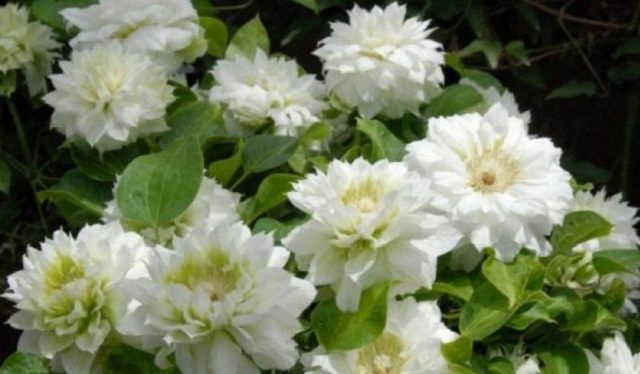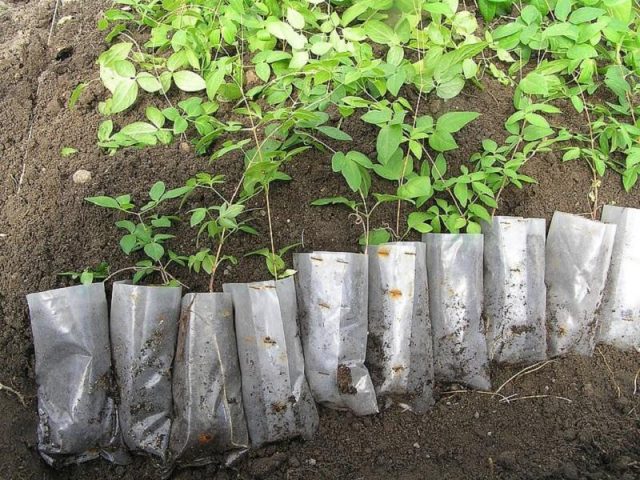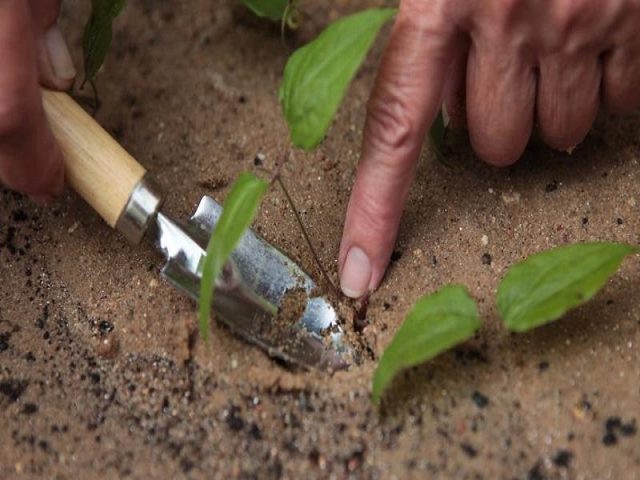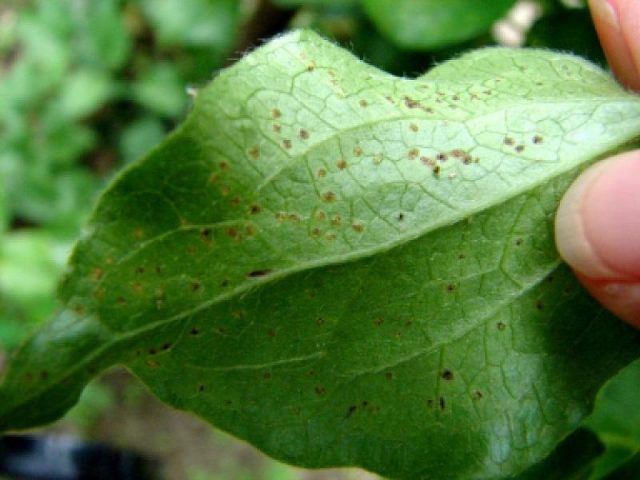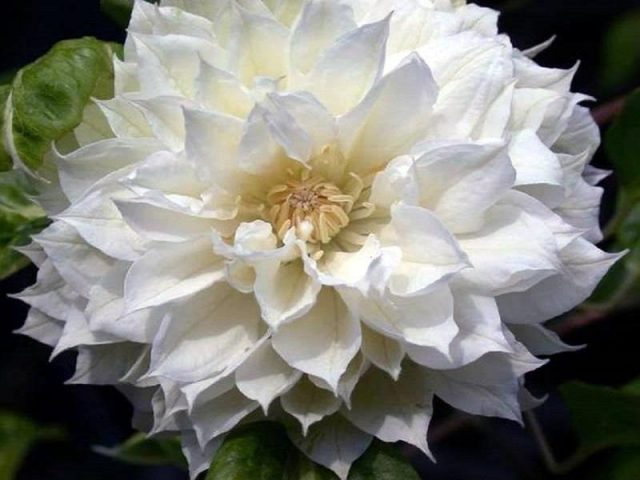Content
Delicate and charming Clematis Duches of Edinburgh is the adornment of any garden. Its appearance is luxurious. White, large, double flowers on lianas, climbing to great heights, amaze with their abundance and splendor.
Clematis has long ceased to be exotic for central Russia. There are many varieties, zoned for different regions, with excellent characteristics. Among them is Duches Edinburgh. Thanks to proper agricultural technology and care, the vine develops rapidly, grows, and decorates the garden with its flowering.
Description of Clematis Duches of Edinburgh
Clematis is an early flowering variety.
- The flowers of the plant are large, snow-white. They can be white with a green center, their diameter is up to 15 cm. The inflorescences are characterized as double and semi-double, spherical, and the stamens are brown.
- The stems of the culture are liana-shaped, curly.
- Leaves are opposite, whole, trifoliate, bright green.
- The roots are cordlike, soft.
The plant blooms in late spring and early summer on last year's shoots. Repeatedly - in September on the growth of this year. Clematis Duches Edinburgh loves sunny places, tolerates partial shade well. It grows at a moderate rate. Decorative properties are used for vertical gardening, the plant looks good when grown near gazebos, fences, trellises. It is able to climb trees, cling to bushes. The liana looks especially great against a dark background.
An adult plant reaches a height of 3 m. Clematis Duches of Edinburgh is winter-hardy, tolerates temperatures up to -34 ⁰С well.
The crop loves fertile soil with a pH of 6 to 7. Loose sandy loam or loamy soil should not be waterlogged.
Clematis Pruning Unit Duches of Edinburgh
Pruning is one of the main activities in plant care. It must be carried out in accordance with the biological characteristics of the Daches Edinburgh variety. The procedure allows you to achieve powerful flowering at an earlier date, high-quality development, growth. Thanks to her, the vine grows safely in one place for many years.
Circumcision is not difficult. It is carried out with a pruner at a certain height. The rules are dictated by the plant's belonging to the pruning group: Clematis Duches of Edinburgh has it second.
In order for the vine to bush and grow better, in the first year after planting, it is worth cutting off all the shoots above the third pair of buds.
In the future, the procedure can be carried out in three ways:
- weak pruning - weak and unripe shoots are cut out before winter, the rest - no more than a third;
- moderate - remove shoots at a level of 1 m from the ground before winter;
- strong - carried out in autumn or early spring at the height of the second pair of buds.
Planting and caring for Clematis Duches of Edinburgh
Before planting, seedlings of clematis Duches Eidenburg are stored at temperatures from 0 oFrom to +2 oFROM.
Once the buds are growing, it is necessary to transfer the plants to a lighted, cool place to avoid stretching. They should be planted in a well-lit area protected from cold winds after the threat of frost has passed. Drops from the roof onto the plant are undesirable. After choosing the territory for planting, you must:
- Dig a hole 60 cm long, wide and deep.
- Place a drainage made of brick, expanded clay 15 cm thick on the bottom.
- Pour 5 cm thick soil.
- Pour a nutritious soil mixture from high-moor peat, earth and compost into the pit.
- Place the seedling in the hole.
- Spread the roots of the plant.
- Fill and compact the soil a little around the roots of clematis.
- Drizzle.
- Mulch the soil.
- Install a support for the vine.
Further care consists in timely watering, dressing, pruning, preparation for winter.
The plant does not like excessive moisture. Watering is enough for him once a week, in the heat - three times. Mulching allows you to preserve moisture and looseness of the soil. If it is not carried out, then the soil near clematis is loosened after each watering.
Top dressing is carried out several times per season. In May - with urea, in summer - with complex flower fertilizer, potassium sulfate - immediately after flowering.
Preparing for winter
The Daches Edinburgh variety is not afraid of frost, but of high humidity and drying out of the roots in winter. Therefore, the protection of culture should be not so much warming as dry. The rhizome should be protected from spring waters. Shelter time is the beginning of soil freezing. Most often, this is the beginning of November. To protect clematis, you must:
- Spud the bushes to a height of 15 cm.
- Install rodent baits.
- Lay boards, spruce branches or polystyrene near the bush.
- Remove the shoots from the support, twist and put on the base.
- Lay boxes and wooden boards on top.
- Cover with non-woven fabric, leaving holes for ventilation.
- In winter, cover with snow on top.
In the spring, Clematis Duches of Edinburgh is gradually freed from shelter. The procedure starts in April and ends in May. This is necessary for the plant to slowly adapt to the spring sun.
It is worth remembering that Duches Edinburgh shows signs of life very late - in May. It is necessary to wait for this moment and not to disturb the root system of the plant in search of buds and shoots earlier.
Reproduction
There are five ways to breed clematis:
- dividing the rhizome;
- seeds;
- layering;
- cuttings;
- vaccination.
To propagate in the first way, you need to dig out the rhizome, cut it into pieces with a sharp knife or pruner and plant it.
The second way is as follows. Clematis seeds are treated with a growth stimulant and sown directly into the ground, in prepared beds. After the appearance of seedlings, they dive at the stage of several leaves, weed, create a shade and shelter for the winter. You can transplant a flower to a permanent place in a year.
To propagate clematis of the Daches of Edinburgh variety, using a layering, a section of the stem with an internode is selected, two leaves are left and deepened into the soil. After that, it is necessary to shade the layers. After rooting, the stem is cut off and the seedling is replanted.
Rooting of cuttings lasts several months. They are cut during the budding period of the Daches Edinburgh variety of clematis. The cut is made at an angle of 45⁰. Their length should be 8 cm. The leaves are shortened, the cuttings are placed in a moist substrate of peat and sand, deepening to the knot. The rooted planting material is transplanted only the next year.
Vaccination is the most time-consuming process and does not often end in success. The roots of varietal clematis are used as a stock, and the young tops of the shoots are the scion. Fusion occurs within a month.
Diseases and pests
To prevent diseases, vines should be periodically examined. Preventing the spread of infections is easier than curing a plant. Among the most common diseases of the Duches of Edinburgh were identified:
- withering - damage to the root system as a result of moisture stagnation;
- gray rot - brown spots on the leaves of clematis, covering the entire plant, often occur in rainy summers;
- powdery mildew - white bloom on leaves and flowers, infection occurs through infected weeds;
- yellow mosaic - an incurable viral disease in which the leaves become yellow and brittle.
Clematis pests of the Daches Edinburgh variety include:
- aphid;
- slugs;
- spider mite.
To combat them, both folk remedies and chemicals are used - Actellik, Ferramol and others.
Conclusion
Clematis Duches of Edinburgh is a real miracle and a godsend for those who love ornamental plants.The vine has a lot of advantages: abundant flowering twice a season, large double flowers of white color, winter hardiness. Caring for a perennial is not difficult, not difficult even for beginners, and the life expectancy is long. Those who once planted this variety in their garden will no longer give up such a snow-white miracle on the site.
